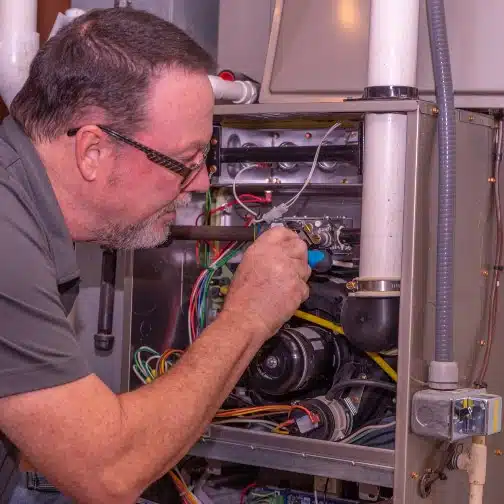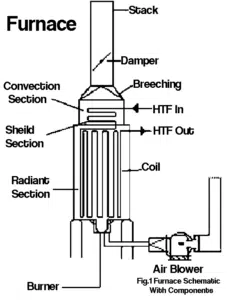heating FAQ
How Does A Furnace Work?
Short Answer: A furnace works by converting fuel, such as natural gas, oil, electricity, or propane, into heat, and then circulating this heated air throughout a building using a blower. Key components involved in this process include a thermostat, burners, a heat exchanger, and a blower fan.

Understanding how a furnace operates is crucial for maintaining a comfortable and safe home environment, particularly in regions such as Chicagoland with colder climates. Furnaces, as integral components of home heating systems, vary in type but share a common purpose: converting fuel into heat and distributing it to provide warmth.
Basic Principles of a Furnace
A furnace, at its core, is a device designed to heat air and circulate it throughout a building. Regardless of the type of fuel used, the basic principle remains the same: converting energy into heat and ensuring its efficient distribution.
The Heating Process
The heating process in a furnace begins with the ignition of the fuel source, be it gas, oil, coal, or electricity. In gas and oil furnaces, this involves burning the fuel, while electric furnaces use heating elements to convert electrical energy into heat.
The Role of the Thermostat
The thermostat serves as the control center of the furnace, dictating when and how much heat is needed. It monitors the ambient temperature and signals the furnace to activate when the temperature falls below a predetermined threshold. This ensures that the heating is not only effective but also efficient, avoiding unnecessary energy consumption.
Circulation of Heated Air
Once heated, the air is circulated throughout the building using a blower. This blower ensures even distribution of warm air, maintaining a consistent temperature across different rooms. In most modern furnaces, this process is finely tuned to maximize comfort while minimizing energy use.
The Importance of Furnaces in Home Heating
Furnaces are more than just heating units; they are central to creating a warm and inviting home during the colder months. Their efficiency and effectiveness in heating play a significant role in ensuring comfort and reducing energy consumption. In colder climates, a well-functioning furnace is not just a luxury but a necessity, providing the much-needed warmth to combat the chill of winter.
Types of Furnaces
While there are various types of furnaces, gas and electric models are the most prevalent. Gas furnaces are popular due to their efficiency and cost-effectiveness, using natural gas as a fuel source. On the other hand, electric furnaces offer a clean and efficient heating alternative, especially in areas where natural gas may not be readily available.
Components of a Gas Furnace
Gas furnaces are complex systems composed of various components, each playing a critical role in the heating process. Understanding these components is essential for comprehending how a gas furnace works and for performing basic troubleshooting and maintenance.
- Thermostat: The thermostat is the control center of the heating system. It monitors and regulates indoor temperature, signaling the furnace to start its heating cycle when the ambient temperature drops below the set point. Located remotely, it is hard-wired to the furnace, ensuring constant communication between the two.
- Control Board: This small circuit board is the brain of the furnace. It interprets electrical signals from both inside and outside the furnace and responds accordingly. For instance, when the thermostat calls for heat, the control board initiates actions like opening the gas valve and turning on the burners and blower fan.
- Burners: Burners are the points where gas is emitted and ignited within the furnace. They create controlled flames that are essential for the heating process.
- Igniter: The igniter is responsible for lighting the gas from the burners. Depending on the model, furnace igniters work either by creating a spark for ignition or by heating a surface to an extremely high temperature that ignites the gas as it passes.
- Blower Fan: This component consists of a motor and a fan that directs warm air from the furnace into various parts of the home as per the heating demands.
- Flame Detector: The flame detector is a safety feature. It prevents the dangerous buildup of gas if the igniter fails. If no heat is detected, the flame detector shuts off the gas flow, ensuring safety.
- Heat Exchanger: The heat exchanger comprises a series of thin-walled metal tubes. It separates the combustion process from the air entering the home. Cold air is blown over the heat exchanger, warming it before being redirected into the home.
- Plenums: The supply-air plenum distributes warmed air to the ducts. In contrast, the return-air plenum carries air from the rooms back to the furnace for reheating.
- Gas Valve: This valve controls the pressure of gas entering the furnace from an external source, like an LPG tank or a natural gas supply line.
- Air Filter: A critical component for maintaining indoor air quality, the air filter traps dust and debris, preventing them from entering the furnace with the cool air.
- Transformer: Transformers supply electricity to the furnace and regulate it to the correct voltage, ensuring the furnace operates safely and efficiently.
How a Gas Furnace Works (Step-by-Step)
Understanding the step-by-step operation of a gas furnace helps in appreciating how this intricate system converts fuel into warmth for our homes. Here’s how a gas furnace works:
- Signal from the Thermostat: The process starts with the thermostat detecting a drop in room temperature below the set threshold. It sends an electrical signal to the furnace, initiating the heating cycle.
- Activation of the Control Board: Upon receiving the thermostat’s signal, the control board springs into action. It orchestrates the sequence of events needed for heating, beginning with opening the gas valve.
- Opening of the Gas Valve: The gas valve opens, allowing natural gas (or propane, depending on the system) to flow into the combustion chamber.
- Ignition of the Burners: The igniter, either creating a spark or heating up to a high temperature, ignites the gas emitted from the burners. This creates a controlled flame necessary for the heating process.
- Heat Generation in the Heat Exchanger: The burning gas in the burners heats the metal walls of the heat exchanger. The heat exchanger is crucial as it transfers this heat to the air while keeping combustion gases separate.
- Circulation of Warm Air: The blower fan then kicks in, pulling cold air from the house through the return ducts. This air is forced over the hot heat exchanger, warming it before being circulated back into the living spaces through the supply ducts.
- Exhausting Combustion Gases: As the furnace operates, combustion gases, including carbon monoxide, are produced. These are safely vented out of the home through the exhaust pipe or flue.
- Regulation by the Thermostat: The entire process is regulated by the thermostat. It continuously monitors the temperature and will signal the furnace to shut off once the desired temperature is reached.
- Continuous Cycle for Maintaining Temperature: As the heated air circulates and cools down, the process repeats. Cold air is continuously drawn back into the furnace, reheated, and redistributed, ensuring a consistent temperature throughout the home.
- Automatic Shut-Off: Once the home reaches the desired temperature, the thermostat signals the furnace to shut off, closing the gas valve and stopping the heating process until the next cycle is needed.
Electric Furnaces: A Comparison
While gas furnaces are widely used, electric furnaces represent a significant segment of the home heating market, especially in areas where natural gas is not readily available. Understanding how electric furnaces operate and comparing them with gas furnaces can help homeowners make informed decisions about their heating needs.
The Electric Furnace: How it Works
- Electric Resistance Heating: At the heart of an electric furnace lies the electric resistance heating element. This is where electricity is used to generate heat, unlike gas furnaces that burn fuel.
- Activation Process: When the thermostat signals the need for heat, electric current flows through these heating elements.
- Heat Generation: As electricity passes through the resistance elements, it generates heat. This process is similar to how a toaster or electric stovetop works.
- Air Circulation: Like gas furnaces, electric furnaces use a blower fan. This fan circulates air from the home through the furnace, where it is heated by passing over the electric coils, and then it is pushed back into the living spaces through ductwork.
Advantages and Disadvantages
- Energy Efficiency: Electric furnaces can be more energy-efficient in terms of the direct conversion of energy into heat. However, this can be offset by the higher cost of electricity compared to natural gas in some regions.
- Installation and Maintenance: Electric furnaces are generally easier and less expensive to install, as they do not require a gas line or exhaust flue. They also tend to require less maintenance than gas furnaces.
- Safety and Cleanliness: Electric furnaces do not produce combustion gases, eliminating the risk of carbon monoxide poisoning. They are considered cleaner, as there is no combustion involved.
- Cost and Availability: The cost-effectiveness of an electric furnace can vary greatly depending on local electricity prices. In areas where electricity is expensive, operating an electric furnace can be more costly than using a gas furnace.
- Lifespan: Electric furnaces typically have a longer lifespan than gas furnaces, as they have fewer moving parts and do not experience the same level of wear and tear from the combustion process.
Two-Stage Furnaces
Two-stage furnaces have two levels of operation – low and high. The low stage is used during milder weather, providing sufficient warmth while consuming less fuel. The high stage kicks in during colder temperatures for maximum heat output. These furnaces are more energy-efficient as they adjust their output based on the specific heating needs, often operating on the lower, more economical stage. By maintaining a more consistent temperature and operating more quietly, two-stage furnaces provide a more comfortable home environment compared to traditional single-stage systems.
Modulating Furnaces
Modulating furnaces can adjust their flame and heat output in small increments, providing precise temperature control. This capability allows for optimal energy usage and efficiency, as the furnace can fine-tune its operation to the exact requirements of the home. With this type of furnace, temperature fluctuations are minimal, ensuring a consistently comfortable indoor climate.
Maintenance and Safety Tips
- Regular Cleaning and Inspections: Regular maintenance, including cleaning of components and safety inspections, is crucial for efficient and safe furnace operation.
- Filter Changes: Changing the air filter regularly, at least every three months during usage, prevents blockages and maintains air quality.
- Safety Precautions: Keeping flammable materials away from the furnace and installing carbon monoxide detectors are essential safety practices.
- Professional Check-ups: Annual or semi-annual check-ups by certified technicians can prevent potential issues and ensure the furnace operates at peak efficiency.
Final Thoughts
Understanding the workings of your home’s furnace, whether it’s a standard, two-stage, or modulating model, is key to ensuring efficient and safe heating. Regular maintenance, understanding of the system’s operation, and timely upgrades or repairs can significantly enhance your home’s comfort and energy efficiency.
If you’re in need of professional furnace services, whether it’s routine maintenance, emergency repairs, or considering an upgrade, Lindemann is here to assist. Our team of experts can ensure that your furnace is operating at its best, providing you with peace of mind and a comfortable home environment. Contact Lindemann today for all your furnace servicing needs and ensure your home stays warm and safe throughout the colder seasons.

